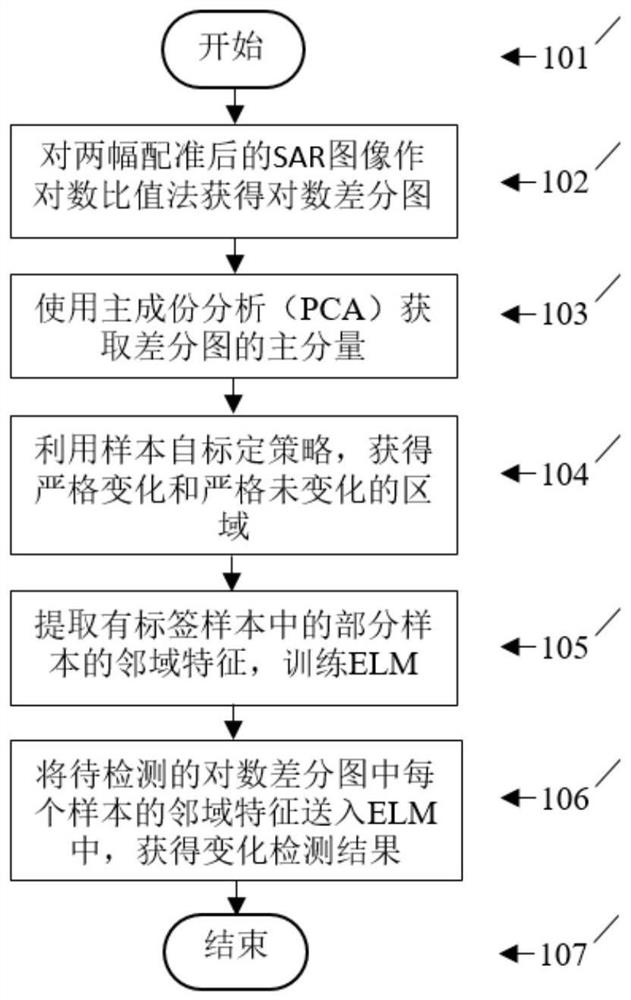On-orbit SAR image change detection method based on sample self-calibration elm
An image change detection and change detection technology, which is applied in image analysis, image enhancement, image data processing and other directions, can solve the problem that the detection accuracy and robustness of the on-orbit SAR image change detection method are not ideal, the resolution of detection results and the imaging method. Instability, inability to flexibly apply different imaging methods, etc., to achieve the effects of excellent calculation results, improved detection quality, and fast calculation speed
- Summary
- Abstract
- Description
- Claims
- Application Information
AI Technical Summary
Problems solved by technology
Method used
Image
Examples
Embodiment 1
[0029] The supervised on-orbit SAR image change detection method is limited by a large amount of manually labeled data, and the method of using ground training data and on-board detection cannot be stably applied to SAR image data of different imaging methods and resolutions. Aiming at this current situation, the present invention explores and improves, and proposes an on-orbit SAR image change detection method based on sample self-calibration ELM.
[0030] see figure 1 : the present invention directly carries out change detection to the registered SAR image on the satellite, specifically comprising the following steps:
[0031] Step 101: Start the on-orbit change detection based on the sample self-calibration ELM.
[0032] Step 102: Pair X of the two registered SAR images of the same area but different time phases taken from the radar 1 and x 2 , where image X 1 Indicates the SAR image of the first phase of the same area, X 2 SAR image representing the second phase of th...
Embodiment 2
[0040] The overall technical solution of the on-orbit SAR image change detection method based on the sample self-calibration ELM is the same as that in Embodiment 1, and the logarithmic ratio method calculation in step 102 of the present invention includes the following steps:
[0041] Step 201: Start the logarithmic ratio calculation.
[0042] Step 202: pair the two registered SAR images of the same area but different time phases taken from the radar to X 1 and x 2 The logarithmic difference graph DI is generated according to the following formula:
[0043]
[0044] Where ε is a very small normal number, and the range of values is generally [10 -4 , 10 0 ];X 1 Indicates the SAR image of the target area before the change, X 2 Indicates the SAR image of the target area after the change.
[0045] Step 203: Normalize the generated logarithmic difference map DI, expressed as:
[0046]
[0047] where DI max and DI min Represent the maximum and minimum values of t...
Embodiment 3
[0050] The overall technical solution of the on-orbit SAR image change detection method based on the sample self-calibration ELM is the same as that of embodiment 1-2, and the principal component of the normalized logarithmic difference map obtained in step 103 includes the following steps:
[0051] Step 301: Start to use principal component analysis (PCA) to extract the principal components of the normalized logarithmic difference graph.
[0052] Step 302: Divide the normalized logarithmic difference image into several non-overlapping image blocks, the size of each image block is k×k, and the size of the image block is set to 5×5 in this example.
[0053] Step 303: pull all the segmented image blocks into a column vector, and call PCA to retain 99% of its information.
[0054] Step 304: Restore the blocks drawn into column vectors to obtain the principal components of the normalized logarithmic difference map.
[0055] Step 305: Finish using principal component analysis (PCA...
PUM
 Login to View More
Login to View More Abstract
Description
Claims
Application Information
 Login to View More
Login to View More - R&D
- Intellectual Property
- Life Sciences
- Materials
- Tech Scout
- Unparalleled Data Quality
- Higher Quality Content
- 60% Fewer Hallucinations
Browse by: Latest US Patents, China's latest patents, Technical Efficacy Thesaurus, Application Domain, Technology Topic, Popular Technical Reports.
© 2025 PatSnap. All rights reserved.Legal|Privacy policy|Modern Slavery Act Transparency Statement|Sitemap|About US| Contact US: help@patsnap.com



